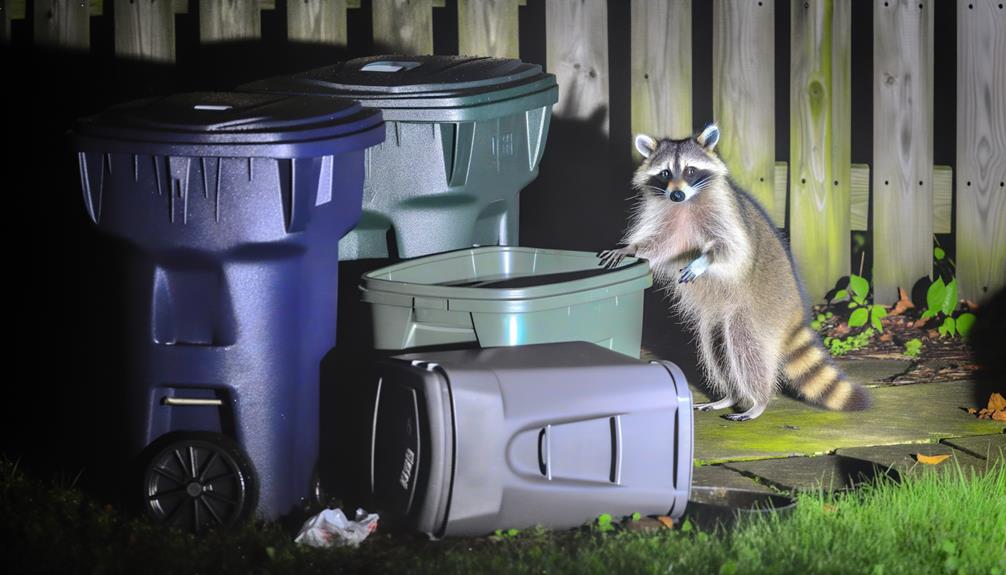How Do Raccoons Get Too Smart to Get Stuck?
Raccoons exhibit advanced cognitive skills, such as exceptional memory, problem-solving abilities, and spatial navigation. Their dexterous forepaws allow intricate manipulation of objects, aiding them in accessing and escaping potential traps.
Raccoons can learn from past experiences, often evading traps and maneuvering urban environments efficiently. They use sensory perception and cognitive mapping to avoid getting stuck in typical predicaments like trash cans or chimneys.
While raccoons can sometimes get ensnared, their behavior often demonstrates high adaptability and intelligence, making them proficient at eventual self-liberation. Insights into their behavior reveal the nuanced strategies they employ for survival.

Key Takeaways
- Raccoons possess high intelligence and problem-solving skills, aiding in their ability to avoid traps.
- Their dexterous paws and cognitive flexibility help raccoons manipulate objects and escape from tight situations.
- Despite their cleverness, raccoons can occasionally get stuck in chimneys, trash cans, and attics.
- Raccoons use keen spatial memory and acute sensory perception to navigate and evade obstacles.
- Behavioral adaptation allows raccoons to learn from past experiences, enhancing their evasion of traps over time.
Raccoon Intelligence
How do raccoons exhibit remarkable problem-solving abilities and cognitive functions that suggest a high level of intelligence among non-human animals?
Raccoons (Procyon lotor) demonstrate advanced cognitive skills through their adeptness at manipulating objects and solving complex puzzles. Research indicates that raccoons possess an exceptional memory, retaining solutions to tasks for extended periods.
Their dexterous forepaws, comparable to primates, enable intricate manipulations, facilitating tool use and innovative problem-solving. Behavioral studies reveal that raccoons can discern cause-and-effect relationships, exhibit foresight, and adapt to changing environments.
These attributes underscore raccoons' cognitive flexibility and learning aptitude, positioning them as highly intelligent mammals. The implications for wildlife management and conservation are profound, necessitating strategies that consider their cognitive capabilities.
Urban Navigation Skills
Raccoons exhibit remarkable urban navigation skills, adeptly traversing complex city landscapes by utilizing their advanced spatial awareness and problem-solving abilities. These nocturnal mammals demonstrate proficiency in recognizing and remembering intricate urban layouts, allowing them to locate food sources, shelter, and safe passageways efficiently.
Their acute sensory perception, particularly olfaction and tactile sensitivity, enables them to detect subtle environmental cues. Additionally, raccoons display a heightened ability to adapt to anthropogenic changes, such as altered traffic patterns and construction zones. Their cognitive mapping capabilities are comparable to those observed in primates, underscoring their exceptional navigational competence.
Understanding raccoons' urban navigation strategies can inform urban planning and wildlife management practices, aiming to mitigate human-wildlife conflicts and promote coexistence in metropolitan areas.
Problem-Solving Abilities
Raccoons exhibit remarkable problem-solving abilities, particularly in their clever food retrieval techniques and their adeptness at escaping traps and obstacles.
Empirical studies have demonstrated that raccoons can open complex mechanisms and remember solutions to tasks for extended periods.
These cognitive skills suggest a high level of adaptability and intelligence, enabling them to thrive in diverse environments.
Clever Food Retrieval Techniques
Demonstrating remarkable adaptability, Procyon lotor exhibit advanced problem-solving abilities in their ingenious food retrieval techniques.
Their cognitive acuity is evidenced by several key behaviors:
- Tool Utilization: Raccoons have been observed using objects such as sticks and stones to extract food from hard-to-reach places.
- Spatial Memory: These mammals can remember locations of food sources and navigate complex environments to access them efficiently.
- Dexterous Manipulation: Their highly sensitive and dexterous forepaws allow them to open jars, unlatch containers, and manipulate intricate mechanisms.
- Sequential Problem Solving: Raccoons can perform tasks requiring multiple steps, such as removing obstacles in a specific order to gain access to food.
These behaviors underscore raccoons' exceptional cognitive capabilities in foraging contexts.
Escaping Traps and Obstacles
In addition to their sophisticated foraging strategies, Procyon lotor exhibit remarkable ingenuity in evading traps and overcoming obstacles, further highlighting their advanced problem-solving abilities. These raccoons demonstrate a keen understanding of their environment, often manipulating objects and mechanisms to escape confinement. Their dexterous forepaws and cognitive flexibility enable them to open cages, lift latches, and maneuver through complex mazes.
| Problem-Solving Behavior | Example |
|---|---|
| Manipulation of Objects | Lifting latches |
| Cognitive Flexibility | Maneuvering through mazes |
| Dexterity | Opening cages |
These behaviors underscore the raccoon's capacity for innovative problem-solving, making them a challenging species to manage in both urban and rural settings. Understanding these capabilities is vital for developing more effective and humane wildlife management practices.
Common Predicaments
Frequently observed in urban and suburban environments, raccoons often encounter various predicaments due to their inquisitive nature and adept problem-solving abilities. These scenarios highlight the intersection between their natural behaviors and human-developed landscapes.
Common predicaments include:
- Trash Can Intrusions: Raccoons frequently find themselves trapped within garbage receptacles after foraging for food.
- Chimney Entrapments: Their exploratory tendencies can lead them into chimneys, where escape becomes challenging.
- Fence Ensnarements: Maneuvering through tight spaces, raccoons can become stuck in fences, especially when evading predators.
- Attic Invasions: Seeking shelter, raccoons may enter attics, resulting in difficulty exiting and potential conflicts with homeowners.
Understanding these predicaments is essential for developing humane strategies to mitigate raccoon-human conflicts, benefitting both wildlife and urban communities.
Escaping Traps
Raccoons exhibit advanced cognitive abilities that enable them to employ sophisticated trap evasion techniques. Studies have documented their use of problem-solving skills and dexterous manipulation to escape various types of traps.
This section will explore these clever escape strategies and their implications for wildlife management and control.
Clever Trap Evasion Techniques
Exhibiting remarkable behavioral adaptability, raccoons employ a variety of sophisticated techniques to elude capture in both traditional and modern trapping mechanisms. Their ingenuity and problem-solving capabilities are evident in their interactions with traps.
Key techniques include:
- Manipulation of Trap Mechanisms: Raccoons often use their dexterous forepaws to disable or trigger traps without getting caught.
- Use of External Tools: They have been observed using sticks or rocks to interfere with trap functionality.
- Behavioral Conditioning: Frequent exposure to traps can lead raccoons to recognize and avoid them altogether.
- Exploit Weak Points: Raccoons target structural weaknesses in traps, such as gaps or unsecured latches, to escape.
These behaviors highlight their advanced cognitive abilities and adaptability, presenting significant challenges for wildlife management professionals.
Common Escape Strategies
One prevalent escape strategy involves raccoons leveraging their dexterous forepaws to manipulate and disarm trap mechanisms, thereby circumventing capture. These agile creatures exhibit remarkable problem-solving abilities, often studying trap configurations before executing their escape. Their forepaws, comparable to human hands in terms of nimbleness, allow them to unlatch doors, pull levers, and even untie knots.
Additionally, raccoons utilize their keen sense of smell and spatial memory to locate and exploit weaknesses in traps. Observational studies have shown that raccoons can learn from prior encounters, adapting their techniques for more efficient escapes. These behaviors highlight the necessity for wildlife management professionals to continually innovate trap designs to stay ahead of raccoons' evolving escape strategies.
Too Smart for Safety?
The cognitive capabilities of raccoons have been observed to pose significant challenges to implementing effective safety measures. Their problem-solving skills and adaptability make traditional deterrents less effective. For those dedicated to protecting wildlife and human environments, it is essential to understand the complexities involved.
Notable observations include:
- Tool Use: Raccoons have demonstrated the ability to use tools to achieve objectives, complicating containment efforts.
- Memory Retention: They possess excellent long-term memory, allowing them to recall successful escape routes.
- Manipulation Skills: Their dexterous front paws enable them to manipulate locks and latches.
- Behavioral Flexibility: Raccoons quickly adapt to new challenges, rendering static safety measures obsolete.
Understanding these traits is fundamental for developing dynamic, effective safety protocols that accommodate raccoons' intellectual prowess.
Human Interactions
In human interactions, raccoons exhibit behaviors that can range from benign curiosity to problematic intrusions, requiring a nuanced understanding of their cognitive and behavioral patterns for effective management. Raccoons are known for their dexterous forepaws and problem-solving abilities, which can lead to complex engagements with human environments. These interactions often require a detailed examination of the circumstances to determine appropriate interventions.
| Behavior Type | Example Scenario |
|---|---|
| Benign Curiosity | Investigating trash bins |
| Problematic Intrusion | Entering attics and basements |
| Cognitive Innovation | Opening pet doors |
| Behavioral Adaptation | Avoiding traps and deterrents |
Understanding these behavioral nuances is essential for developing humane and effective strategies to manage raccoon interactions in human-dominated landscapes.
Conclusion
Raccoons exhibit remarkable intelligence, urban navigation skills, and problem-solving abilities, often likened to a locksmith deftly manipulating intricate mechanisms.
Their capacity to escape traps and navigate common predicaments underscores a level of cognitive sophistication that raises questions about their safety in urban environments.
Human interactions with raccoons must consider these traits to mitigate conflicts and promote coexistence.
This balance necessitates a nuanced understanding of raccoon behavior to develop effective management strategies.






